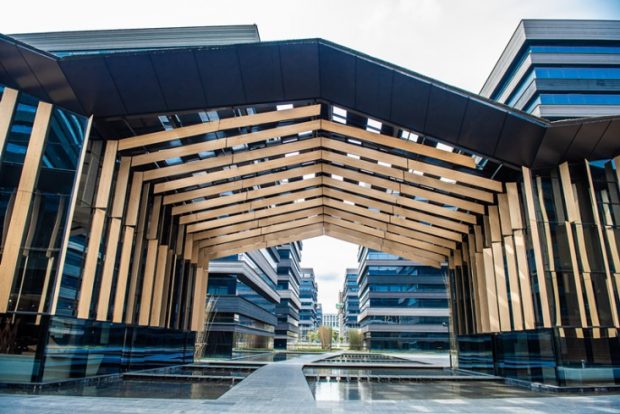Shanghai builds CIIE into constant trading platform

The photo shows the exterior of Hongqiao Import Commodity Exhibition and Trading Center. (Photo provided by the Administration Committee of Shanghai Hongqiao Central Business District)
Shanghai is currently digging more potential of the China International Import Expo (CIIE), turning the 6-day event into an all-year-round trading platform. The first CIIE attracted 3,617 foreign exhibitors to Shanghai within only 6 days last November, and generated total trading value of $57.8 billion. To sustain the performance, Shanghai opened an import commodity exhibition and trading center a month after the conclusion of the event, bearing a hope to turn exhibits into commodities.
So far, over 20 commodities that were popular at the first CIIE have been introduced to the Hongqiao Import Commodity Exhibition and Trading Center, including Spanish cured ham, Australian wines and Japanese rice. The center provides a package of services including bonded exhibition, transaction, logistics and storage, and customs clearance. Bonded trading has two major advantages when compared with the traditional mode in which duties are usually paid before transaction. On one hand, it enables merchants to pay their duties after the sales, which grants the merchants more flexibility of cash flow by lowering capital occupation; on the other hand, the commodities, if failing to find the proper markets, can be returned to the bonded warehouses and shipped to other destinations without paying duties.
A rice brand from Japan’s Hokkaido witnessed huge popularity at the first CIIE. Its products later completed debut in the Chinese market under the bonded exhibition trading service by Shanghai Pushihui Import and Export Co. Ltd. Under the innovative mode, the rice is directly transported to a bonded warehouse beside the Hongqiao Import Commodity Exhibition and Trading Center, and duties will be collected at the end of each month after the products are sold. Thus, the price of the rice is 10 percent lower thanks to the cut of cost. The import commodity exhibition and trading center, as a pilot platform of bonded trading, was established under the cross-department efforts of Shanghai Customs, Shanghai Municipal Commission of Commerce and the Administration Committee of Shanghai Hongqiao Central Business District.
The platform reviews the information of applying merchants and adopts dynamic supervision, and takes control of the commodity quality through access threshold and withdrawal mechanism. Furthermore, the platform offers preferential prices of rent, “zero charge” of bonded warehouse and information services, as well as duty-assessment on actual prices, in a bid to save logistics and capital cost for enterprises. More than 400 brands and 8,000 commodities from over 50 countries have entered the first phase of the Hongqiao Import Commodity Exhibition and Trading Center, according to an official from the Administration Committee of Shanghai Hongqiao Central Business District. Now the planning of the second-phase project has been completed, and a bonded logistics center for multi-users will be put into use at the second CIIE, the official introduced. To make full use of the spillover effect of the CIIE, Shanghai is speeding up in building a new mechanism for an open economy at a higher level. A slew of innovative mechanisms have been rolled out, such as the acceptance of inspection results for imported commodities, the pilot program of overseas pre-inspection for products to be debuted in Shanghai, and the pre-classification mechanism for newly released products.
By doing so, Shanghai aims to build itself into a globally renowned shopping center, a major destination of first launches, a prioritized destination for high-end brands, and a hub for original brands. In addition, the city has set up relevant standards to attract brands to stage “world debuts” of products and to open world’s first flagship franchises in Shanghai. It enhanced efforts on the protection of trademarks of “first-launch” products, and included qualified brands debuting their products in Shanghai in a key protection list. Owing to the policies and regulations in the past, time and places of foreign brands’ marketing campaigns and promotions were always limited, which resulted in a weak motivation for internationally renowned brands to debut their products in Shanghai. To change the situation, Shanghai Landscaping and City Appearance Administrative Bureau opened a “green channel” to build the city into a destination for more “world debut” activities. Statistics indicated that in 2017, a total of 1,265 domestic and foreign brands chose Shanghai as the place to make the initial launch of their products. The figure doubled between Jan. and Oct. 2018, with 2,890 renowned brands organizing “world debut” activities in the city.
By Tian Hong
(People’s Daily)

























































